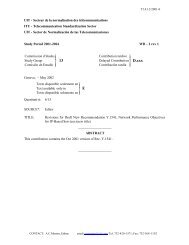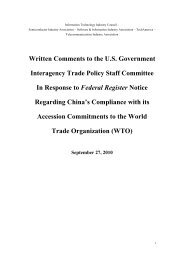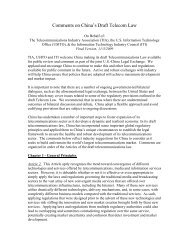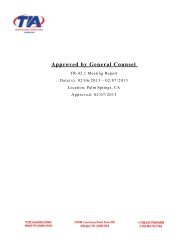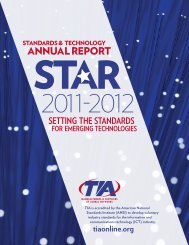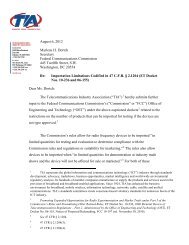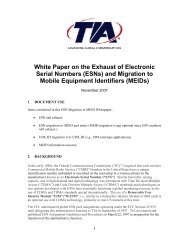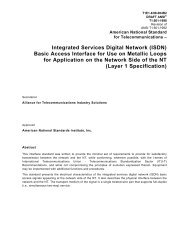ITU-T V.150.1
ITU-T V.150.1
ITU-T V.150.1
- No tags were found...
Create successful ePaper yourself
Turn your PDF publications into a flip-book with our unique Google optimized e-Paper software.
There are two phases in the process to determine the configuration of the TCX. The first phase is<br />
the capability exchange phase. This occurs during the call set-up. These messages are defined in<br />
clause 15.2.2 and are exchanged between the On-Ramp and Off-Ramp gateways. The gateways<br />
declare whether they are of the None, Single or Double Trans-Compression types.<br />
For the case where both G1 and G2 declare they are Double Trans-Compression Gateways, their<br />
initial configuration can be Single-to-Single configuration or if both Gateway’s indicate their desire<br />
they can mutually choose the Symmetric Double Trans-Compression configuration. This option is<br />
indicated as part of the Gateways compression capability message during the call set-up phase (See<br />
clause 15.2.10).<br />
As a result of the Trans-Compression capability exchange the gateways shall select the mode of<br />
operation as defined in Table 1.<br />
TABLE 1/<strong>V.150.1</strong><br />
Trans-Compression Mode Selection<br />
Trans-Compression Mode<br />
Capabilities Exchanged<br />
Resultant Trans-Compression Mode<br />
Selected by Gateways<br />
G1 G2 G1 G2<br />
No No No No<br />
No Single No No<br />
No Double No Double<br />
Single No No No<br />
Single Single Single Single<br />
Single Double Single Single<br />
Double No Double None<br />
Double Single Single Single<br />
Double Double Single/Double* Single/Double*<br />
* Note: If both Gateways indicate their ability and desire to support<br />
Double-Double configuration it shall do so, otherwise they shall use the<br />
Single-Single configuration<br />
13.6 XID/LR Profiles for use in Modem Relay Connection Scenario MR1<br />
Modem relay connection Scenario MR1 requires both M1 and M2 to negotiate identical<br />
compression parameters. This section defines an optional method to provide the ability to predict<br />
trans-compression parameters based upon knowledge gained from a previous connection or by<br />
other means. This will allow the Gateways to optimize the protocol XID/LR exchange for improved<br />
connect time, compression efficiency, and connectivity.<br />
The gateways may exchange their knowledge as described in 22.2.5, and use this information to<br />
agree on optimal and consistent XID/LR command and response sequences that each will send<br />
when the particular physical connection comes up.<br />
The advantage of using this prior knowledge is that an actual synchronous end-to-end exchange is<br />
not necessary, thus minimizing the timing problems associated with such exchanges.<br />
<strong>ITU</strong>-T Rec. <strong>V.150.1</strong> (01/2003) – Prepublished version 22




